report
Digital Space is...
Introduction
Angelique welcomes participants and sets the schedule for the day. For this final session, makers are meeting at The Grey Space in the Middle in The Hague, a research space for residencies, music, parties, and supporting smaller artists by providing stages and opportunities. The Grey Space is known for its “non-disciplinary” and cross-disciplinary approach.
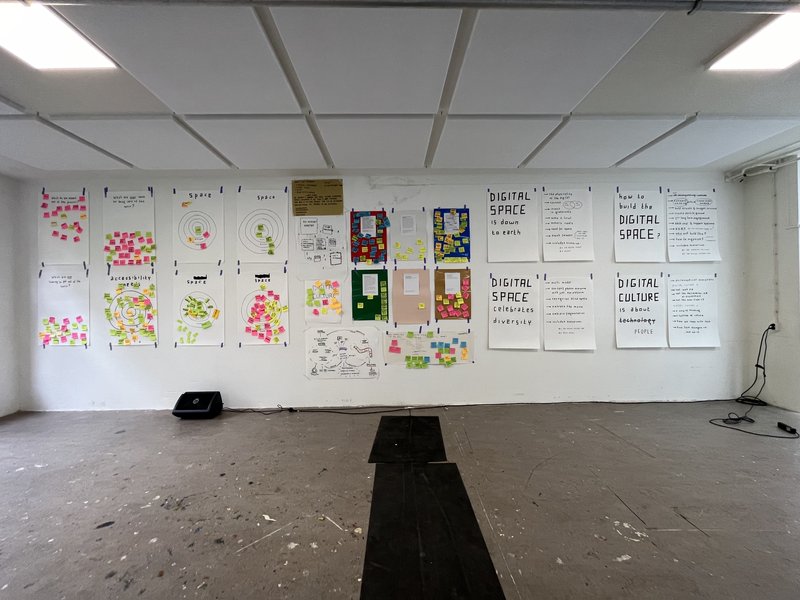
To refresh the makers, Rogier walks through the maps created during the last sessions, covering metaphors, examples, common grounds, values, accessibility, care rider, and more. He invites participants to review the maps, emphasizing the importance of having questions for DEN and fostering a collaborative environment. Each group will then present their work, and we will conclude with a plenary discussion, just like last time, ending with thoughts on how to continue and making a plan to turn our sessions into a manifesto/mind map.
In the second session, the discussion centered around developing a model that adheres to specific principles, translating these principles into the physical space itself, and creating a care rider map reflecting the role of the makers in this project and future spaces. Key themes that emerged included funding, engagement, and an open-source philosophy. Participants expressed concerns about becoming overly dependent on algorithms.
In the third session, participants’ fears, dreams, and key themes were explored through various scenarios focusing on ethics, core values, collectiveness (reflecting on engagement), and a multimodal platform (emphasizing accessibility). Participants were divided into diverse groups to tackle each scenario. One group reflected on how to implement a code of values in technology, while another group examined a scenario through the metaphor of “bringing a chair to the public space.” The OSET group concentrated on providing assistance to makers and organizations with infrastructural issues and questions. Another group envisioned a maker cafe where people could present their projects and connect, fostering meet-ups and a local dynamic similar to the hybrid events of The Hmm. The multimodal group aimed to facilitate connections among makers in a playful, professional manner, akin to a professional Tinder for makers. Finally, the hybrid scenario explored ways to blend digital and physical interactions, highlighting the need for a physical space where makers can meet and collaborate.
Today is more of a hands-on session. We recap all previous sessions and bring together all the elements in this fourth session. We aim to investigate how DEN approaches digital culture by stepping back from the specific scenarios to question the overarching assignment. It appears that DEN may hold outdated views of makers and might not fully consider the cultural aspects. Participants will first contemplate what they believe is important to share with DEN, identifying key themes. They will then be divided into groups based on these themes to reflect on and summarize their thoughts, ultimately coming to well-informed conclusions.
During the feedback session, participants noted some areas for improvement. They indicated that there were reflectioninconsistencies in the terminology used on each poster, raising questions about their interrelation. Rogier answered that there was a consensus that today’s activities would clarify these issues, acknowledging that they were working on the same topic from different perspectives. Moreover, participants found it challenging to challengeapply their ideas due to the multiple layers involved, leading to extensive questioning. They highlighted the importance of sharing with care and ensuring that the themes and questions presented serve as a recap of the overall sessions. Additionally, participants aimed to show DEN that the “black scenario” do not align with what creators want and need. The most important objective for the day was to have a meaningful discussion and collaborate effectively with DEN.
Themes
The groups have the opportunity to present their outcomes in any format they choose, such as creating a manifesto, video, workshop, or traditional presentation, to share their ideas with DEN. They have a total of two hours to create their presentations, followed by a discussion and presentation session with DEN.
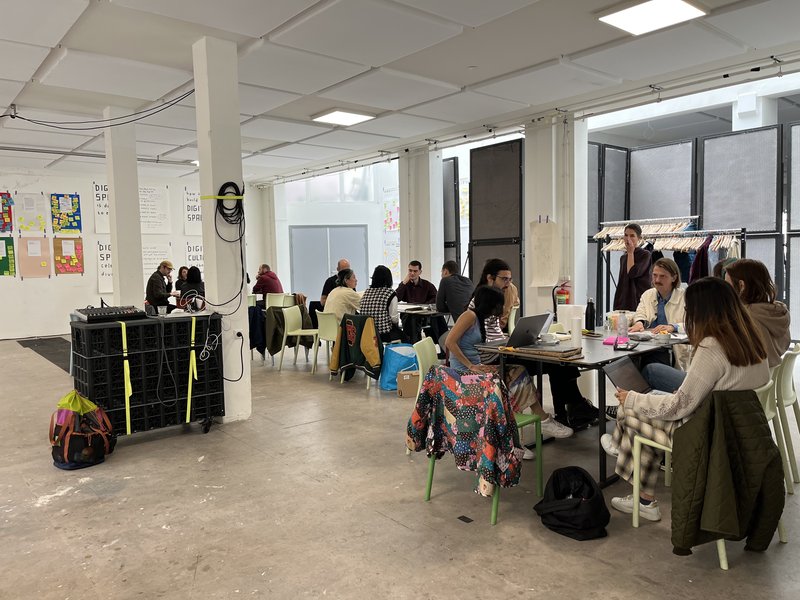
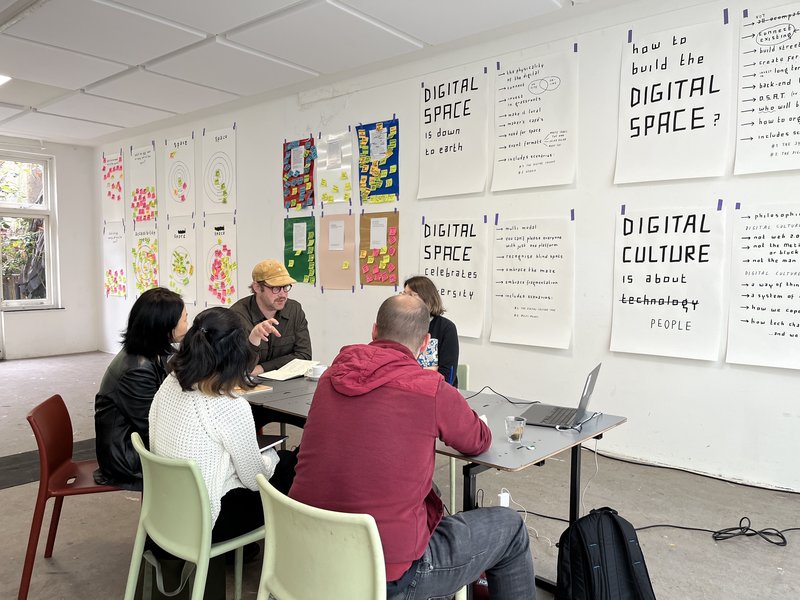
1 - Digital Space is Down to Earth - Soyun, Kwan, Roberto, Jonas, Philip
Jonas raised the question of questionwhat can attract people to such initiatives and whether knowing where they are helps. Soyun noted that while people are fluid, opinionfeeling grounded by participating in something can be appealing. Kwan added that although some are accustomed to fluid spaces, not everyone is willing to dive in; opinionlabels and systems can provide comfort, pointing to the need for balancing digital literacy with concrete actions. Soyun appreciated that this conversation is already taking place. Moreover, Jonas wondered about reflectionbreaking assumptions regarding physical, hybrid, and online spaces. Phillip emphasized the opinionimportance of understanding the materiality of experiences, as digital media always has a physical component.
Key concepts discussed included desiregenerating new impulses to stimulate local communities and improving the accessibility of archived information. Jonas questioned whether they should present an idea, a format, or a brainstorm to DEN. Rogier provided context about DEN’s role in researching future audiences and aiding digitalization in the cultural sector. red threadDEN aims to build a "common space" online to help people find all cultural initiatives in the Netherlands. Jonas asked questionwhat resources could be shared on both a platform and in a physical space. They considered interesting-practicelocation-based ideas, like bike trips with stamps, reminiscent of the early days of the web, as a way to engage people and integrate both digital and physical experiences.
2 - Digital Space Celebrates Diversity - Alice, Genevra, Hermen
Angelique raised the question of questionhow accessibility solutions can be made bidirectional. Alice emphasized the opinionimportance of following a UX workflow that includes people from various roles—organizations, curators, artists, and especially a team of accessibility experts. Decisions need to come from a diverse team. Herman highlighted the desireneed for transparency in decision-making processes. Additionally, Angelique pointed out that interesting-practicetechno-centric solutions often fail, as evidenced by the Van Gogh museum example. Alice noted that the first step is always to ask, “What is needed?” Angelique suggested that opinionmatchmaking could be a starting point alongside addressing accessibility questions, emphasizing the importance of matching visitors with the right app or resources, as not everyone can be included in a one-size-fits-all approach. Futhermore, Genevra added that accessibilityaccess also involves sharing; for those without the means to travel, spaces can facilitate sharing through videos, descriptions, and other resources. Angelique questioned reflectionwhether people would be willing to pay for such accessand suggested different types of curatorship. She proposed a buddy system where people build bonds of trust and choose each other. Genevra stressed the importance of interesting-practicedesigning a format first, allowing modalities to develop from this framework through matchmaking. Teams could generate modalities and use the platform as a mediating tool. This approach could take various forms, such as encouraging users to put their phones away to engage more deeply.
The discussion touched on the danger of concernsimply replicating existing solutions, such as just creating a livestream. The core issue is determining reflectionwho makes decisions within institutions regarding access and how to include the audience in these decisions. Designing the format is crucial, as it lays the foundation for diverse and effective modalities to emerge.
3 - How to build the digital space? - Karl, Kay, Bianca, Oana, Yu
Bianca suggested using spaces in new, creative ways while sharing resources and interesting-practicebuilding bridges between platforms, people, and communities. Kay asked if this approach would require a larger audience, and Bianca affirmed, emphasizing the need to invite more people. Karl highlighted the opinionimportance of access to mentorship and orientation. He noted that interesting-practicenot being on social media excludes him from many things, so a more connected network of individual websites or spaces could foster independence and collaboration outside social media. Existing tools like newsletters are a start, but better platformsinfrastructure and protocols are needed to connect people sustainably, especially considering the potential decline of major platforms like Meta.
Harm questioned questionhow to include DEN in this conversation, to which Kay responded that the challenge lies in challengegetting people to pay attention. Yu shared that interesting-practicegetting honest reviews and feedback on her articles is difficult, suggesting that a opiniondigital space could facilitate an artist network with benefits like discounts, creating a new economy of the commons.
Besides, Bianca likened metaphorartists and organizations to pedestrians and buildings, suggesting that they can choose to open their doors. Harm emphasized the need to connect these actors to develop the pathway between them. Oana proposed the city metaphor as more useful, and Bianca agreed, suggesting the creation of a metaphorcity map for digital spaces. Harm added that this city should have many homes, starting with some of the significant existing buildings, envisioning a metaphordigital city with diverse and interconnected spaces.
4 - Digital Culture is about people - Lea, Ananya, Florian, Nikola,
Lea expressed confusion about the reflectionaudience targeted by DEN for the new platform, emphasizing the need to establish clear terminologies. The group wanted to understand DEN members’ views on digital culture by assigning them different roles and asking various questions. They aimed to uncover how DEN consumes digital culture, their screen time, the content they consume, the channels they use, and their perspective on the government’s role in creating new platforms.
Florian highlighted that the desireplatform's value lies in increasing the time makers spend together, whether online or offline. Lilian questioned the necessity of assigning roles, suggesting these inquiries were personal. Lea proposed agreeing on the intent behind these questions beforehand. Florian clarified that quotethe goal was not to make everyone digital natives but informed users, emphasizing the need to prioritize questions and determine the direction of the discussion.
The group considered an interactive format, with Florian suggesting anonymity through post-its and a moderator. There was a proposal to have participants guess who answered each question, but Lilian noted there wouldn’t be enough time. Lea suggested that each person could moderate a question, while Florian expected DEN to have their questions, proposing that they also use papers to write them down. Lilian suggested creating a mind map titled “Digital culture is…” to gain insights into DEN’s perspective and work towards a shared definition of digital culture.
For a 45-minute session with DEN, they decided to narrow down their questions. Each member marked their favorite questions, eliminating some like “What is your YouTube history?” and “Who do you want this platform to be for?” Ultimately, they chose “What is your screen time?” as an icebreaker. The final list included:
-
What is your screen time?
-
What was your first encounter/interaction with the digital?
-
What is the most frequent app you use?
-
What do you like about it? What do you not like about it?
-
What app makes your life more fun?
-
How do you like to consume culture?
-
How has your online work/personal life changed over the last five years?
They planned to set a timer for each question to maintain structure and find a suitable order for the discussion.
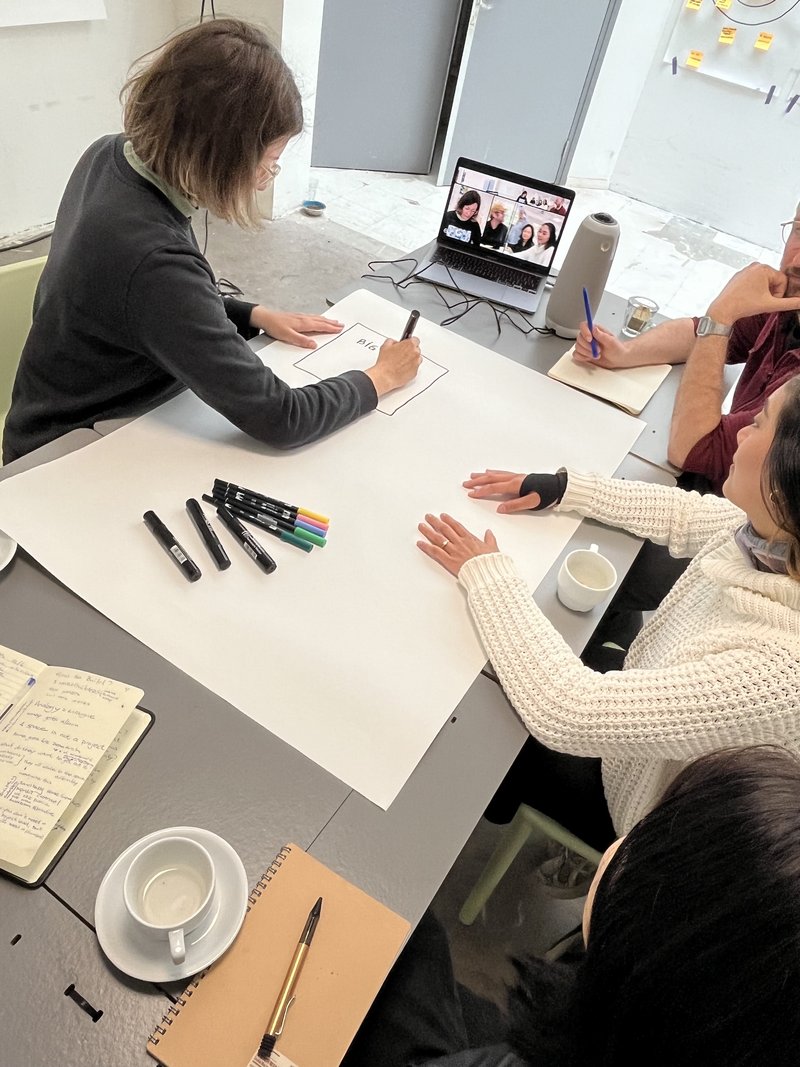
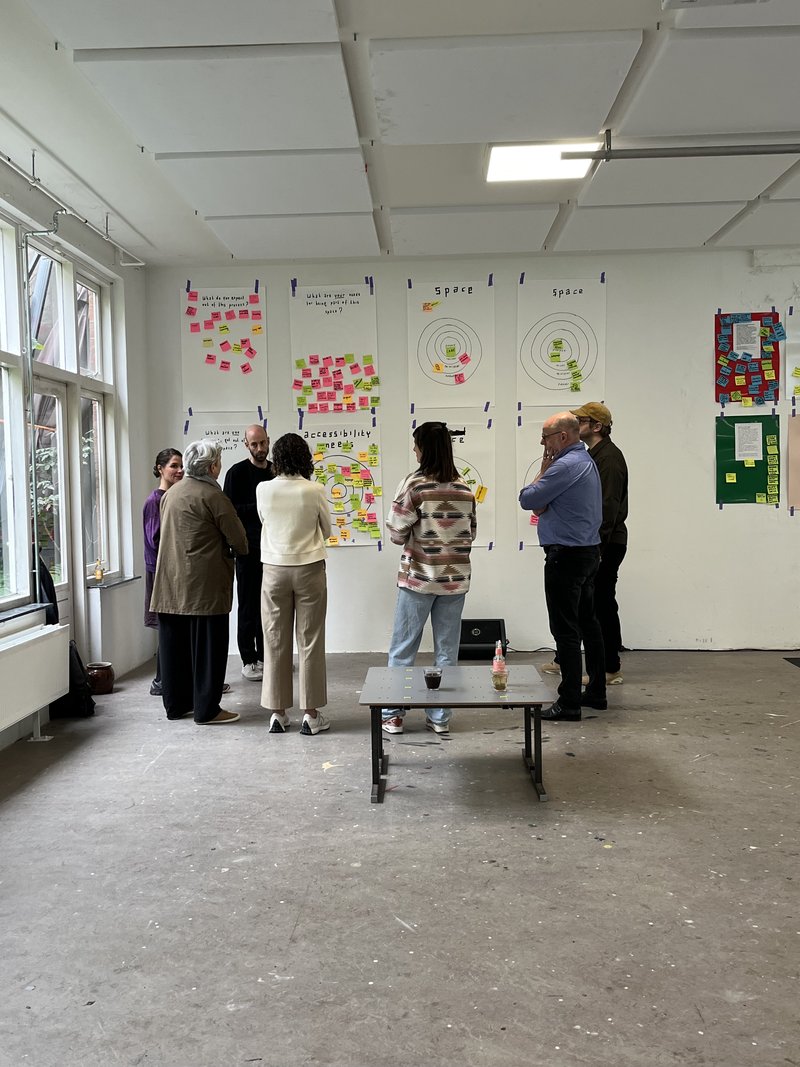
Presentations
- Group 1: digital space is down to earth The group posed the question, “questionWhat happens if we focus on the potential of the local? What kind of spaces and digitalization would we use?” Emphasizing engagement with existing physical spaces, they aimed to desirestimulate knowledge exchange. Although working with technology makers, there’s a interesting-practicesense of alienation from technology itself, necessitating ways to navigate this and find resources for smaller organizations. platformsDigital spaces should serve as hubs for moderation and exchange. While digital platforms offer platformsaccessibility and centralized information, local engagement should be encouraged without curating a single centralized platform. They proposed utilizing underused spaces, desirefacilitating sharing between artists and researchers—for example, repurposing nightlife venues for daytime use. They envisioned spaces like hair salons or public squares where people can gather and converse, highlighting the intrinsic value of such cultural spaces and making the process economically viable.
The audience was asked, “questionWhen did you think a digital tool made you feel more connected to the physical space?” Responses included Facebook events, music apps, and local WhatsApp groups. They also discussed reflectionwhether there should be maps showing local physical resources and if local ambassadors should report on smaller spaces, raising questions about who decides these roles. Lea suggested feedback mechanisms like “cultural queering the map,” while Florian emphasized that real-life experiences are interconnected and opinionfeedback should be immediate, unlike current funding plans.
Group 2: digital space celebrates diversity
To design for groups that are typically left out, it’s crucial to inclusionfoster collaboration and ensure that participants do not feel lost in the process. While diverse modalities are common on websites, the goal here is desirenot to design the modalities themselves but to create a format that allows these modalities to emerge organically. This includes mechanisms like solutionmatchmaking and promoting long-term investment and engagement. By forming various teams, modalities can become desireopen-source formats that help multiple institutions rather than being owned by any single one. Multiple institutions could crowdfund a shared modality that benefits everyone, not tailored for specific institutions. This approach introduces inclusionalternative ways of navigating platforms for people with specific needs and ensures that these modalities continue to be tested and evolve based on user interaction, setting new standards for cultural institutions with more representation and participation. Designing these modalities would involve teams of artists, researchers, and organizations, with desireresearchers playing a key role in developing the modalities by leveraging their expertise to approach the problem from diverse perspectives. Institutions could inclusioncommission researchers to identify different needs and integrate them into the modalities. DEN might consider reflectionwhether these modalities can also serve as filters, depending on the audience and purpose, such as art performances connecting viewers differently than museum displays or passive live stream watching. Involving the audience as a fourth player in defining modalities, either through expert researchers or directly including users, can bring greater inclusivity and diversity into the process.
Group 3: How to build the digital space? - Karl, Kay, Bianca, Oana, Yu
The group discussed questionhow to create new connections between different, siloed spaces. Despite the abundance of open standards and practices for sharing data, active participation is essential. They envisioned a website, OSINT(https://etherport.org/publications/the-hmm/Voices_of_Makers/reports/7-scenarios.html), to house data such as events, calendars, open calls, job postings, and blog posts. However, challengemaintaining this resource up-to-date remains a challenge. The technical aspects are manageable, but the real hurdle is challengeidentifying each organization's incentives, as individuals and smaller organizations are the primary beneficiaries. The challenge lies in challengemotivating larger museums to participate. DEN recognized these concerns, with Herman questioning questionwhy museums would join. Oana responded that museums seek to reach new audiences, needing both artists and a combined audience of large and small entities.
DEN questioned the questionbalance between interest and idealism, emphasizing the project’s role in supporting smaller organizations while also needing champions from bigger institutions. Kay mentioned a past project where Wikipedians photographed archives and collections, noting that once the Van Gogh Museum participated, others quickly followed. Soyun highlighted a discussion about using existing resources, suggesting a solutionshared protocol to scrape data. Kay confirmed this concept exists in public spaces but hasn’t been adopted widely due to concerninstitutions not recognizing the urgency. With growing awareness of social media issues, people now desire more distance from it.
DEN asked about questionusing algorithms to steer audiences to new experiences. The group emphasized desireavoiding a single large platform and instead proposed systems tailored to each space. Karl suggested solutioncreating multiple entry points for information. DEN inquired questionhow this approach could feed audience curiosity and explore new spaces. Kay envisioned this as fostering solutioncross-institutional solidarity, supporting both larger and smaller entities in a collaborative ecosystem.
Group 4: Digital space is about people
The group crafted questions to engage the audience in reflecting on digital culture, asking: “questionWhat was your first encounter with the digital, and how did this experience change your life?” Participants shared diverse responses: Soyun mentioned a video game, Lea discussed how it influenced her perception of technology, Angelique described shifting from paper to a computer, which allowed her to manage notes more efficiently, and Pernilla from DEN recalled making a color book on the screen and printing it on a large plotting machine, transitioning from digital back to physical. These responses illustrated the multifaceted nature of digital engagement and experience. The second question was, “questionHow do you see the role of the government compared to market-driven consumption in the digital realm?” Here, opinions varied: Angelique noted that the government can support what the market neglects, though this could have negative aspects, while Florian pointed out that government reforms can inform market behavior. The discussion highlighted a recurring debate about the roles of public versus private sectors. DEN, acting as an NGO, aims to drive digital innovation in a culturally resistant sector. quoteThe government often funds initiatives to spur future-oriented possibilities, illustrated by the Ministry of Culture commissioning DEN to brainstorm a platform for makers. This approach provides a safer path for the ministry, which is not typically geared towards long-term innovation. interesting-practiceDespite ample funding for culture, the Netherlands still faces challenges in balancing innovation within this sector.
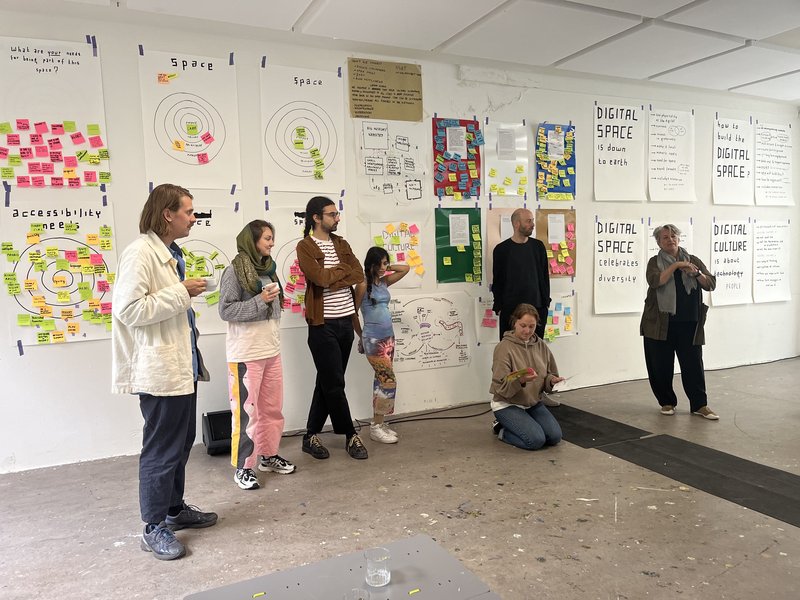
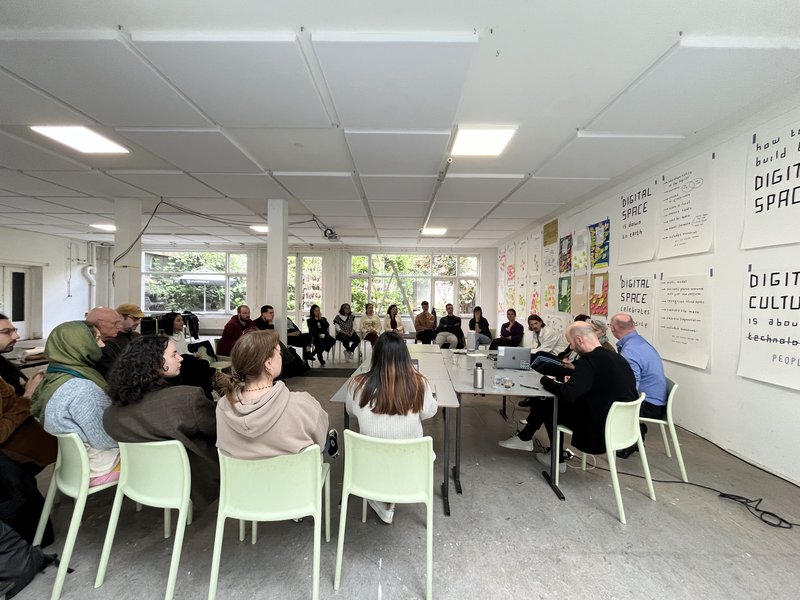
Conclusion
To continue with this project and ensure the group’s vision is effectively communicated and aligned with the Ministry of Culture’s goals, several key steps and roles for group members have been outlined. Maike from DEN highlighted the inclusion of artists and makers in the discussion on digital transformation, emphasizing the importance of leveraging their skills and creativity. This approach has opened up new possibilities for Maike and the group. Priscilla from DEN praised the creation of maps and identified key resonant topics: red threadopen-source data, accessible information, and the need for community and physical/digital connections. She emphasized that solutionDEN should present various scenarios rather than a single solution to the Ministry. Moreover, Beert from DEN expressed relief and gratitude for the valuable input from makers, which helped clarify the blueprint’s main axes: red threadprioritizing people over technology, balancing freedom and control, and focusing on accessibility and inclusivity. Maike sought the group’s input on the three main ideas to present to the Ministry, with Kay suggesting the importance of desiredistributing efforts across multiple initiatives, sharing open data, and fostering local making communities rather than centralizing everything. Lea emphasized that opiniondigital culture often defies expectations, while Florian stressed that opiniondigital culture is an integral part of overall culture, not just about technology. Interestingly, Alice viewed opiniondigital culture as a tool rather than a goal, and Genevra highlighted the importance of delegating to diverse stakeholders. Florian suggested applying resources from groups like theirs to support the initiative. Maike noted that concernorganizations are often resistant to change due to fear and cost, and stressed the need for organizational changes and upskilling. Beert acknowledged the expense of uncertainty with change.
To effectively present their ideas to the Ministry, the group agreed on using solutionsimple, relatable language, illustrations, and videos. Florian suggested starting with a common understanding of digital culture and digitalization. They planned to define what digital culture is and isn’t, and what changes they want to see. Herman noted that everything is now digital to some extent, and interestingly, VR/XR was not mentioned!
For the next step, DEN will schedule an online meeting to gather feedback from institutions, aiming to finalize the presentation before summer and present it to the Ministry in September, with a follow-up after the summer break. The makers are all excited to hear back from the Ministery’s opinion on their ideas!